Burial › Butrint › Etruscan Society » Origins and History
Articles and Definitions › Contents
- Burial › Origins
- Butrint › Origins
- Etruscan Society › Origins
Ancient civilizations › Historical places, and their characters
Burial › Origins
Definition and Origins

Burial of the dead is the act of placing the corpse of a dead person in a tomb constructed for that purpose or in a grave dug into the earth. In cultures such as Mesopotamia, tombs and graves were cut into the ground in the expectation that the soul of the individual so buried would more easily reach the afterlife which was thought to exist underground. Graves in the cultures of the ancient world were usually marked by a stone bearing the person's likeness and name or by an elaborate tomb (such as the pyramids of Egypt or the tholos tombs of Greece ) or megalithic stone dolmens, passage graves, and cairns such as those found in Scotland and Ireland.
Whatever kind of grave or tomb was constructed, however, the importance of the proper burial of the dead was emphasized by every ancient culture and the rites accompanying burial were among the most elaborate and significant in many ancient cultures. Burial of the dead in the ground has been traced back over 100,000 years of civilization as evidenced by the Grave of Qafzeh in Israel, a group tomb of 15 people buried in a cave along with their tools and other ritual artifacts. The earliest grave uncovered thus far in Europe is that of the `Red Lady of Wales' which is 29,000 years old.
BURIAL PRACTICES IN MESOPOTAMIA
Burial in Mesopotamia began c. 5000 BCE in ancient Sumer where food and tools were interred with the dead. According to the historian Will Durant, "The Sumerians believed in an after-life. But like the Greeks they pictured the other world as a dark abode of miserable shadows, to which all the dead descended indiscriminately” and that the land of the dead was beneath the earth (128). Because of this, it seems, graves were constructed in the ground to provide the deceased with easier access to the nether world.
Throughout Mesopotamia those who were not royalty were buried below the family home or next to it so that the grave could be regularly maintained. If a person was not buried properly they could return as a ghost to haunt the living. This haunting could take the form familiar from popular ghost stories or films where a disembodied spirit causes problems in the home or, more seriously, as a form of possession in which the spirit entered into the individual through the ear and wreaked havoc on one's personal life and health.
Cremation was uncommon throughout Mesopotamia owing to the scarcity of wood but, even if fuel for a fire had been available, the Mesopotamians believed that the proper place for the souls of the dead was in the nether world of the goddess Ereshkigal and not in the realm of the gods. If one were cremated, it was thought, one's soul ascended sky-ward toward the home of the gods and, as a human soul, would not be at home there. It was far more fitting for one's soul to descend to the underworld with other human souls. In the region of Mesopotamia which came to be known as Babylonia it was believed that the dead “went to a dark and shadowy realm within the bowels of the earth, and none of them saw the light again” (Durant, 240). In Babylonia the dead were buried in vaults although, as Durant notes:
A few were cremated and their remains were preserved in urns. The dead body was not embalmed, but professional mourners washed and perfumed it, clad it presentably, painted its cheeks, darkened its eyelids, put rings upon its fingers, and provided it with a change of linen. (240)
This burial process would be developed further by the Egyptians.
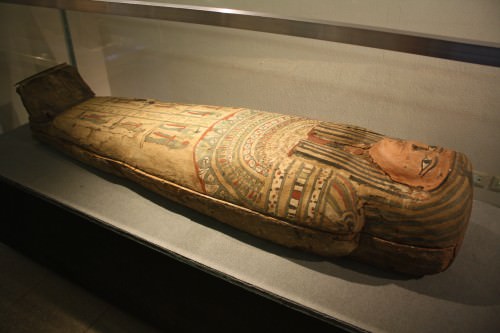
Egpytian Sarcophagus
BURIAL IN EGYPT
In Egypt the dead were also buried underground and, famously, in the pyramids of such as those at Giza. Durant writes:
The pyramids were tombs, lineally descended from the most primitive of burial mounds. Apparently the Pharaohbelieved, like any commoner among his people, that every living body was inhabited by a [spirit] which need not die with the breath…The pyramid, by its height, its form and its position, sought stability as a means of deathlessness. (148)
For the more 'common' of the Egyptians, however, a grave in the earth was the usual final resting place. The deceased would be buried with grave goods and as many shabti dolls as a family could afford to help with chores in the afterlife. Burial practices in Egypt extended to one's pets and Herodotus has recorded how, in an Egyptian home which has lost a cat, the family would shave their eyebrows and observe a period of mourning on par with the death of a human being. Cats were mummified as were dogs and other pets (such as baboons, gazelles, birds, fish) and rituals observed at their passing.
For both common Egyptians and royalty, sacred spells from the work known as The Egyptian Book of the Dead were recited in order to direct the soul toward the Hall of Truth and the judgement of the great god Osiris. Osiris would then weigh the heart of the deceased against the white feather of Ma'at (truth and harmony) and, if one's heart was found lighter than the feather, one was given passage to the Field of Reeds, the Egyptian paradise which was an eternal mirror image of one's life on earth. If one's heart was found to be heavier than the feather of Ma'at, however, it was thrown to the floor where it was eaten by the god Amenti (also known as Amut) and the soul of the individual then ceased to exist. In ancient Egypt, non-existence was the worst punishment imaginable.
The Egyptian tradition among royalty of creating great monuments and tombs inscribed with their deeds was observed to make sure the ruler would not be forgotten by the living and so would continue to exist on earth even after death. To erase one's memory on earth was to erase one's immortality and this is why Tuthmoses III, who vandalized the public statuary of Queen Hatshepsut, left those monuments to her which were out of the public eye untouched. He may have wanted to discourage other women from following Hatshepsut's example in the future but did not wish to condemn her to non-existence by removing all trace of her name and deeds.
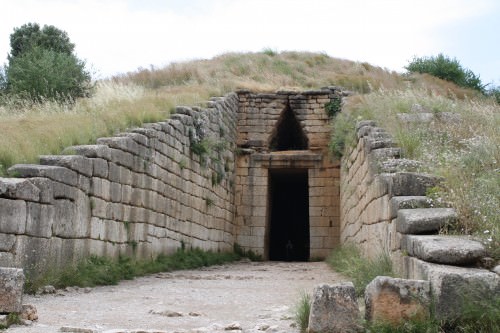
Treasury of Atreus, Mycenae
BURIAL RITUALS IN GREECE
Ancient Greece also employed burial under the earth and, as previously noted by Durant, continued the tradition of the after-life existing below the ground. The ancient Greeks (perhaps following an Egyptian tradition) made sure to provide their dead with carefully carved stones to remind the living of who the deceased were and what honors were still due them.Remembrance of the dead was a very important civic and religious duty, not simply a personal concern, and was dictated according to the concept of eusebia which, though frequently translated into English as `piety', was much closer to `civic duty' or `social obligation'.
Eusebia dictated how one should interact with one's social superiors, how the youth treated their elders, how masters interacted with slaves, and how husbands treated their wives. It also extended, though elevated to the concept of housia (holiness) to one's relationship with the gods. Different Greek city -states observed their own particular burial rites but the one aspect they all had in common was the continued remembrance of the dead and, especially, their names.
Sons were named for their father's father and daughters for their mother's mother in order to preserve the memory of that individual (to take one example, Aristotle 's son, Nichomachus, was named for Aristotle's father). Whether buried in an elaborate tomb or in a simple grave, the Greeks maintained that the dead must continually be remembered and respected in order for their souls to continue to exist in the afterlife.

The Temple of Kukulcan (El Castillo) at Chichen Itza
MAYA BURIAL RITUALS
The Maya viewed life after death as a dismal world fraught with peril and darkness and their burial rites centered on directing the soul in the right path toward freedom from the underworld. The dead were buried with maize placed in their mouth as a symbol of the rebirth of their soul and also as nourishment for the soul's journey through the dark lands of Xibalba, the nether world, also known as Metnal.
Bodies were positioned in graves underground, as in Mesopotamia, to allow easy access to Xibalba and were aligned in accordance with the directions of the Mayan paradise (north or west). As the color red was associated with death, corpses were sprinkled with the shavings of the red mineral cinnabar and were then wrapped in cotton for burial. The Mayan afterlife was a terrifying place of demons that could as easily harm one as help one in the soul's journey toward paradise and perhaps the cinnabar was thought to disguise the soul as one of these infernal spirits and so help the individual in their journey through the afterlife.
Everyone who died descended into the darkness of Xibalba except for those who died in childbirth, in battle, in sacrifice, or by suicide. `Sacrifice' included death incurred during the play of the ball game Pok-a-Tok, considered the game of the gods.However one died, the rites of burial were more or less the same except, of course, for kings and nobility.
BURIAL RITES IN INDIA
In ancient India, as throughout India's history, cremation was the usual practice in caring for the dead. Durant writes:
In Buddha ’s days the Zoroastrian exposure of the corpse to birds of prey was the usual mode of departure; but persons of distinction were burned, after death, on a pyre, and their ashes were buried under a top or stupa –ie, a memorial shrine. In later days cremation became the privilege of every man; each night one might see fagots being brought together for the burning of the dead. (501)
Even so, that was not the only means by which the dead were sent on to the next realm. It is also recorded that the elderly would often choose to have themselves rowed out into the middle of the Ganges River where they would then fling themselves into the sacred water and be swept away. Most people, though, were cremated and their ashes then strewn in the waters of the Ganges, thought to be the source of all life.
Depending on one's actions, beliefs, and behavior in life, the soul then rose to join with the Oversoul (the Atman) or descended back to the earthly plane in another incarnation. According to Hindu belief, the soul would continue to take on as many bodies in as many lifetimes as necessary to finally free one's self from the cycle of re-birth and death; a belief also held by Jains and Buddhists.

Roman Sarcophagus
ROMAN BURIAL CUSTOMS
According to Durant, “Suicide under certain conditions has always found more approval in the East than in the West” but, as in India and with the Maya, the Romans also honored those who killed themselves as they believed it was preferable to disgrace and dishonor. The Roman belief in the continual presence of one's ancestors in one's life encouraged the practice of taking one's life in order to prevent shame attaching itself to the family name. There was, therefore, no difference, in pre-Christian Rome, in the burial of a suicide and one who died by other means.
The Roman burial practices always took place at night in order to prevent disruption of the daily activities of the city. A funeral procession began in the city and ended outside the walls at the cemetery. In order to maintain the boundary between the living and the dead (and also, no doubt, simply for health concerns) no one could be buried inside the city. The corpse was then either burned, and the ashes gathered in an urn, or interred in a tomb.
So important was the proper burial of the dead to the Romans that funeral societies, known as collegia, were common in which members paid monthly dues to make sure their funeral rites would be performed in accordance with tradition and their status in the community. Those who were buried without the proper rituals could return as ghosts. In Rome, as in other civilizations, ghosts were as much a part of the natural world as any other phenomena and were usually feared (an exception being the spirit of a loved one delivering a message). Proper burial of the dead with all attendant rites, therefore, was considered vital in keeping the dead happily in their place and the living untroubled by spirits in theirs.
CHINESE BURIAL RITES
The Chinese burial practice, no matter what era or dynasty, was conducted with ritual ceremonies and the inclusion of personal property in the tomb or grave of the deceased. The particular items interred with the dead changed with dynasties and the passage of time but the belief in an afterlife which was very much like earthly existence (similar to the Egyptian concept in many ways) maintained that the dead would need their favorite objects, as well as things of value, in the other world.
According to The British Museum, “Chinese burial practices had two main components: tombs and their contents, and ceremonies to honour the dead, performed in temples and offering halls by their relatives.” The tomb of the first emperor of China, Qin Shi Huangti, is the most famous example of Chinese burial practices in the ancient world. Shi Huangti's tomb was designed to symbolize the realm he presided over in life and included all he would need in the next - including a terra cotta army of over 8,000 men - and the rites observed at his funeral were elaborate versions of those common throughout China.
In the Neolithic village of Banpo, for example, people were buried in individual graves c. 4500 BCE along with their possessions and tools. What rituals may have accompanied these early burials is not known. Later, however, as one's ancestors were considered an important influence on one's life, and their continued existence in the afterlife a certainty, prayers were offered both to those who had gone before and to the principle of divine harmony to aid the dead person in transition from this world to the next. As in Rome, Egypt, and other cultures, proper burial of the dead was considered most important in allowing the dead to rest in peace and prevent a haunting by an angry ghost.

Balnuaran of Clava
BURIAL IN SCOTLAND & IRELAND
Burial practices in Scotland and Ireland were remarkably similar early on in that both cultures built cairns, dolmens, and passage graves to house their dead. It is not known what precise rites were performed at the funerals in ancient Scotland or Ireland because there is no written record of these proceedings. It seems that burial in cairns dates to at least 4000 BCE while burial in graves becomes more common c.2000 BCE. Wooden coffins also appear in the 2000 BCE range along with personal possessions buried with the dead.
As so many cairns were looted through the centuries, whatever may have been interred in burial has long ago been carried away from them. Some, however, like the famous dolmen of Poulnabrone (County Clare, Ireland) still had enough grave goods and remains for archaeologists to be able to positively identify it as an important burial site. The Neolithic site of Clava Cairns (Inverness, Scotland) is another example of an intact burial site which also seems to have served astronomical purposes.
More modest graves which held the dead in coffins or sarcophagi were more often overlooked by looters and so their contents remain better preserved. In these cultures, as in the others, a belief in the continued existence of the soul after death prevailed and, while their precise rites are not known, they most probably were similar to those of other cultures and included prayers and supplications to higher powers for aid in the journey of the deceased. Although there is no written record of a belief in the afterlife from these cultures, the cairns, dolmens, and passage graves themselves attest to this belief in their construction and orientation with astrological directions and events.
With the coming of Christianity to Ireland and then Scotland, the burial rites became Christianized and are known through the written record. Although Christ was then addressed as the higher power that would comfort and lead the dead toward the afterlife, it is thought that this deity simply replaced the older, pagan, god who would have previously been featured in the rituals. This same process of the `Christianizing' of older burial rituals and rites took place in every culture where Christianity established itself and, most notably, in Rome. It was the city of Rome from which the Catholic traditions concerning burial originated and developed into the most common customs surrounding modern day burials, whether secular or religious, in the west.
Butrint › Origins
Definition and Origins
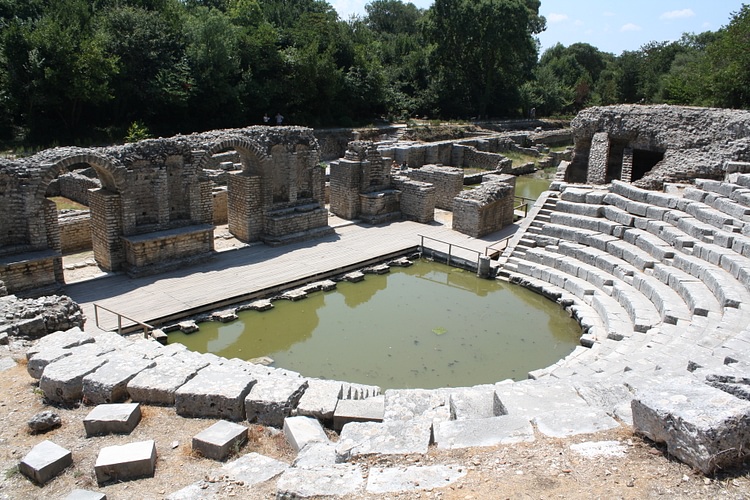
Located on the fertile coast of Epirus in present day Albania, Butrint (ancient name Buthrotum ) was an important settlement in Hellenistic and Roman times due to its position on the route from Italy to mainland Greece down the Ionian Sea, its safe anchorage, inland access via Lake Butrint and its proximity to Corcyra ( Corfu ).
GREEK BUTRINT
Settled since the Bronze Age, the site was certainly in contact with the Greek civilization from the 7th century BCE as potteryfinds from Corinth and Attica attest. Indeed, archaeological remains suggest that an archaic temple sanctuary was present on the site from the 5th century BCE, possibly in honour of Zeus Soter. Polygonal fortification walls also remain from this period.In all probability, Butrint was at one time a colony of Corcyra, just a few kilometres across the sea. From the 4th century BCE it is likely that Butrint became subject to the Chaonians, who controlled the Epirus region and had their capital at Phoenice.
THE ROMANS GAVE BUTRINT PARTICULAR IMPORTANCE VIA THE AENEID OF VIRGIL WHICH HAD THE HERO AENEAS STAY AT THE SITE
HELLENISITC PERIOD
In Hellenistic times from the 4th to 3rd century BCE, fortification walls of large rectangular cut blocks were constructed with various monumental gates. A large sanctuary to Asclepius was also constructed on the southern slopes of the acropolis, probably around a sacred spring. In the 2nd century BCE the site was extensively developed with funding from offerings made at the sanctuary and many buildings were constructed including a theatre and agora with stoas.
ROMAN PERIOD
Butrint came under Roman control in 167 BCE but maintained a high degree of autonomy. The Romans gave Butrint particular importance via the Aeneid of Virgil which had the hero Aeneas stay at the site and attributed a Trojan ancestry to the town, claiming the settlement was founded by the seer Helenus, son of the Trojan King Priam. Julius Caesar visited Butrint in 44 BCE and in 48 BCE it formally became a Roman colony. Butrint was not only strategically important in controlling local sea-routes but was also of commercial interest in terms of agriculture. Indeed, the millionaire Titus Pomponius Atticus had owned property in the area from c. 68 BCE.
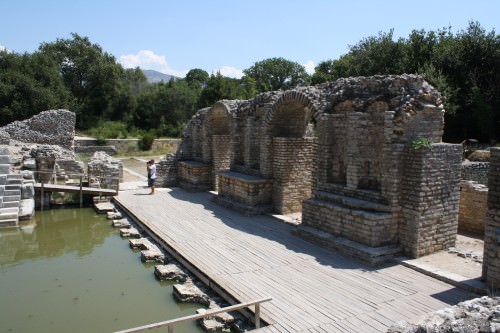
Stage Buildings of the Theatre of Butrint
The town once again received Roman investment in the Augustan period after Augustus ' victory in 31 BCE over Mark Antony and Cleopatra at Actium, just 100 km to the south. Butrint officially adopted the Latin language, established a senate and was given the right to mint coins. Various building projects were instigated including a bath house with under-floor heating, a road bridge, a nymphaeum (public decorative fountain), an aqueduct, three shrines - one dedicated to Minerva Augusta - and the paving of the agora and adaptation into a Roman forum. From the 1st century CE, the outer suburbs of the town were also further developed and its grid road system was typical of Roman town planning.
In the 2nd century CE the theatre was expanded with the stage area being monumentalised and the forum was further beautified with shrines and dedicatory statues. From the 2nd to the 3rd centuries BCE the outer suburbs of the town saw the construction of large private villas with large central peristyle courts, ornamental pools and fine mosaic floors. Extensive architectural damage occurred to various buildings on the site sometime in the 4th century CE and may have been caused by the large earthquake of 365 CE which struck the whole Balkan area. Despite some evidence of reconstruction attempts, the site never recaptured its former prominence and from the 5th century CE Christian buildings were constructed including a large basilica and Baptistery.
Etruscan Society › Origins
Ancient Civilizations
The social organisation of the ancient Etruscans, a civilization which flourished in central Italy between the 8th and 3rd century BCE, can only be pieced together from a collection of rather unsatisfactory sources which, unfortunately, do not include texts written by the Etruscans themselves. These sources include short inscriptions, art, tombs and their contents, pottery graffiti, and descriptions by Greek and Roman writers who often struggled to fathom this strange foreign culture and could only inadequately apply to it their own familiar terms and concepts. Nevertheless, by combining all of the historical records available to us some important elements of Etruscan society become clear: a strong sense of family and heritage, defining symbols of rule and status, and a more liberal attitude to the role and rights of women compared to contemporary ancient societies.

Etruscan Mother & Child
FAMILY
Probably the most important element which held together the fabric of Etruscan society was the family and kinship. The separation of particular families as individually identifiable groups is first seen in the earliest cemeteries at Etruscan sites where each settlement has multiple cemeteries, probably one for each kin group, in a trend which would persist throughout the culture's history. Family was important whatever one's social position as it was from one's parents that one's status derived, whether it be the throne or a pottery work bench.
FAMILY WAS IMPORTANT WHATEVER ONE'S SOCIAL POSITION AS IT WAS FROM ONE'S PARENTS THAT ONE'S STATUS DERIVED, WHETHER IT BE THE THRONE OR A POTTERY WORK BENCH.
From the 7th and 6th century BCE, the presence of large, well-built stone tombs for certain members of the community and the higher value grave goods they contained are an indicator that a wealthy elite had formed within Etruscan society. Over time, the number of such tombs grew as a proportion of all burials within a community, illustrating that this elite grew in numbers from a few tribal leaders to a separate upper class all of its own. Indeed, such was the growth in elite tombs that they were constructed according to orderly grid plans at such places as Cerveteri, creating, in effect, cities of the dead with their own streets. Instrumental in this prosperity was the increase in mining of Etruria 's rich mineral resources and the resulting trade benefits from that exploitation. There was also an elite within an elite as only 2% of tombs at Tarquinia, for example, had expensive wall paintings in their interior. Finally, many tombs were used over several generations, again illustrating the importance and continuation of strong family ties.
MONARCHY & ARISTOCRACY
At the top of the Etruscan social ladder were the royals. Inheriting their right to the throne, the early kings, no doubt, also performed a religious function in a culture where religion and politics were not separated. We know some of the names of Etruscan sovereigns: the Tarquins from Tarquinia who ruled early Rome ; the Tolumnia clan of Veii ; Porsenna, king of Chiusi ;and Mezentius, ruler of Cerveteri. Kings carried the title of lauchume and were recognised by various symbols and insignia such as an ivory throne or stool, a sceptre topped by an eagle, the fasces symbol of axe and rods, and a purple robe; all of which would later be adopted by the Romans.

Vel Saties & Arnza, Francois Tomb
Eventually, kings gave way to rule by a council of elders or an assembly of citizens where the city 's most powerful men met and debated government. The wealth of these individuals was based on land ownership and trade. They voted for a leader amongst themselves, the princeps civitatis, to hold office for one year and, with him, various magistrates to perform public duties, perhaps represent the interests of certain sections of society, and to dispense justice. Inscriptions indicate that a magistrate ( zilath ) could hold office several times and there was no minimum age. Senior magistrates from each of the major Etruscan towns met annually, although that probably had more to do with religious matters as there is no evidence of a common political policy amongst the towns.
OTHER CLASSES & OCCUPATIONS
Etruscan art and especially those tombs with wall paintings reveal other layers of society. Besides the depiction of such elite-only pastimes as feasting and hunting, there are, either by direct depiction or intimation, clearly other, lower members of society such as slaves who serve at banquets, cooks, or beaters during hunts, as well as dancers, acrobats and musicians to provide entertainment. Some jobs are also directly depicted such as fishermen, priests, shepherds, and farmers.
We can deduce, then, from this pictorial evidence and the presence of manufactured goods within the tombs that Etruscan society consisted of slaves, artisans, metalworkers, potters, the tomb painters themselves, those who worked the land (including serfs) and kept animals (whether for themselves or an estate owner), merchants, administrators, a priesthood, and an aristocracy. Further, art can also reveal social attitudes, as for example, in the convention of depicting slaves in wall paintings as of smaller stature than citizens. Similarly, elite members of society were easily identified in real life from the mass of ordinary citizens by their particular clothes, hats, and various staffs of authority. The full significance of such symbols remains uncertain, nevertheless, it is clear that Etruscan society had many levels of complexity. Inscriptions and naming conventions also show that there was some movement between social groups, even if it took several generations to get there.
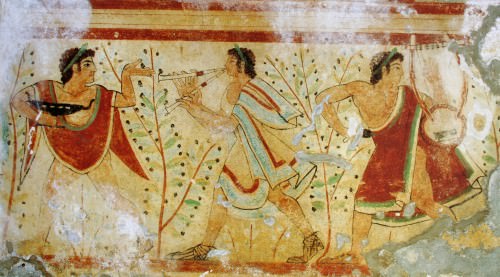
Musicians Wall-painting, Tarquinia
SLAVES
As in contemporary ancient cultures, the Etruscans, or those who could afford them, used slaves for all manner of daily tasks.Taken as prisoners of war from conflicts with fellow Etruscan cities or communities outside Etruria, or simply bought from the Etruscan's trading partners, they came from all over the Mediterranean and were used as household servants, agricultural workers, miners, quarry workers, potters, metalworkers, soldiers, and entertainers. They were not entirely anonymous as some tomb paintings sometimes carry the names of slaves depicted in banqueting scenes. One can imagine that the life of a household slave was rather more bearable than slavery in the mines or countryside and their accommodation certainly was, residing as they did, in the family home.
SLAVE REVOLTS PROBABLY INVOLVED ETRUSCAN CITIZENS TOO, AS THE DISTINCTION BETWEEN SLAVES, FREED SLAVES, & LABOURERS HAS BEEN DIFFICULT TO IDENTIFY.
Unsurprisingly, slave revolts frequently broke out into an armed uprising, especially from the 4th century BCE onwards. These revolts probably involved Etruscan citizens too, as the distinction between slaves, freed slaves, and labourers has been difficult to identify and confused Greek and Roman writers whose descriptions we rely upon for an insight into the Etruscan world. Dionysius of Halicarnassus famously described those disenfranchised in Etruscan society as free men who were treated like slaves. Clearly, there was a wide divide between the have and have-nots, whatever their political and legal status.Then, as perhaps still today, only economic power brought real political influence and the opportunity to improve one's lot.
WOMEN
While paintings in tombs depict the elite's pleasures and pastimes, they also reveal an attitude to women which is quite different from, for example, contemporary Greek culture. Although the Etruscan drinking parties, and even the after-dinner games, are taken from Greek habits, the presence of respectable married women (identified as such by inscriptions), and not courtesans, illustrates that Etruscan women had rather more social freedom than their counterparts elsewhere. In one tomb painting, three women are spectators at a chariot race, again, something unheard of at Greek sporting events.
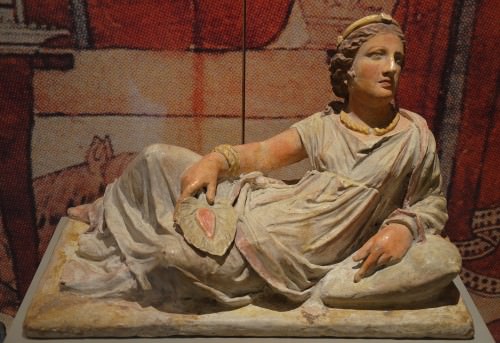
Etruscan Funerary Portrait
Further, records show that Etruscan women were literate and enjoyed greater legal rights, too. In Etruria, a woman could inherit family property if there were no surviving male line, not so in Greece. Property ownership and the right to drink wine is additionally proven by graffiti on pottery vessels which tell of a female owner. That women had their own legal personalities, as it were, is further indicated by numerous inscriptions where they are referred to by both their first and family names, a convention not seen, for example, in ancient Rome. Grave goods buried with females from all periods show their important societal role as weavers, but there are even large grandiose tombs built specifically for a female occupant, the mid-7th century BCE Regolini-Galassi tomb at Cerveteri being the best example. Finally, sarcophagi with lids carrying sculpted figures of deceased couples show the husband in the subservient act of anointing his wife with oil, a touching scene not often depicted in the art of other ancient cultures.
LICENSE
Article based on information obtained from these sources:with permission from the Website Ancient History Encyclopedia
Content is available under License Creative Commons: Attribution-NonCommercial-ShareAlike 3.0 Unported. CC-BY-NC-SA License